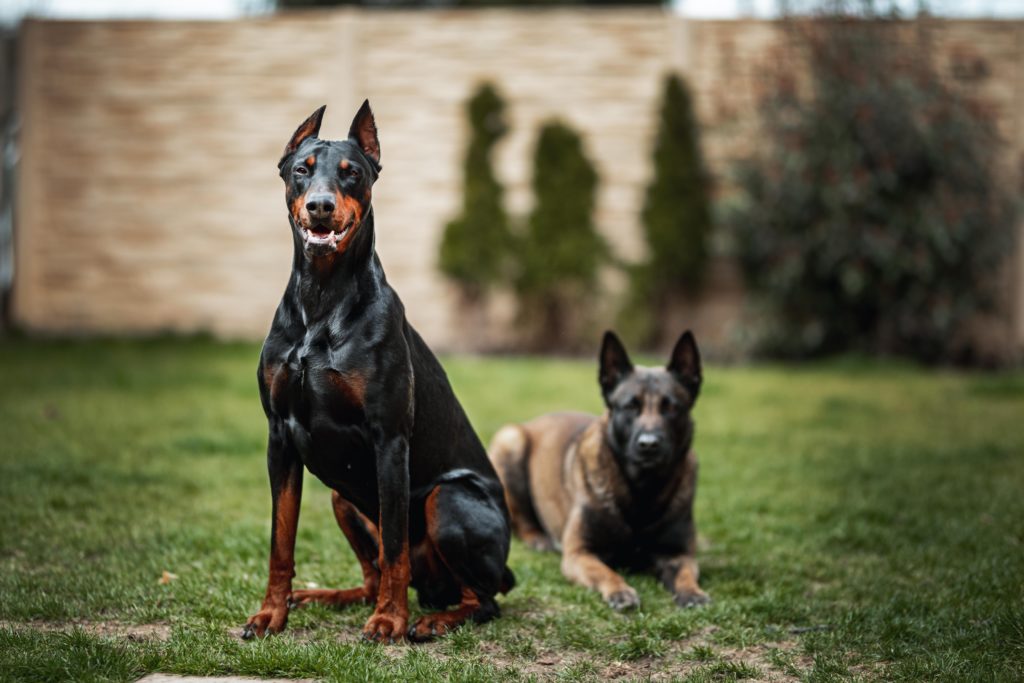Our dogs will have obedience training and they will listen to you but as a well known dog trainer once said “A dog can love you and not respect you”.
People often think they can just bring a new dog home and let the dogs work things out themselves because their dogs are not aggressive. In some cases yes this can work but reality is that dog fights are possible and unless you take the proper steps you could find yourself in a potentially dangerous situation. It has nothing to do with the new dog been protection trained or even the breed. A dog’s world revolves around their pack structure and how they rank within that pack.Bringing a new dog into a home is always an exciting experience but there are some things to consider.
Dogs have an intense genetic pack instinct and adding a second or third dog to the household can trigger this instinct which can create a tense and stressful situation or start a fight. Even your sweet & loving Fifie can turn into a little monster if he or she all of the sudden finds a German Shepherd or any other dog in their house. There could be territorial issues, maybe rank or dominance problems, or there can be inter-male or inter-female issues that result in aggression between the dogs.
Remember that 3 or more dogs are a considered a Dog Pack and when you have a dog pack the dogs natural instincts are heighten. They will become more territorial, pack leadership becomes more important and if the human is not strong enough then always one of the dogs will feel the need to instinctively step up and lead and it’s not natural for most so they can become stressed and even nervous.
It is not our intention to scare you but rather to inform you and help you avoid mistakes. If we are a strong human pack leader none of the before mentioned happens and the transition or introduction of the new dog to your existing ones will be easy and positive.It’s our job as the human pack leader to make it absolutely clear to our dogs that we are in charge, always, and that aggressive behavior will not be tolerated.
Please read our article on “Bonding with your new dog”http://www.ivanm2705stg.wpengine.com/bonding-with-your-new-dog because the first few weeks will set the stage for the rest of your dogs life. The most important part of this process is to get and use dog crate. When your new dog gets home he should be placed in his crate and allow your existing dogs to come by and smell the newcomer. If there is any growling you are to immediately correct the offender and make it clear aggression toward one another will not be tolerated and folks saying “Be a good boy fife” won’t cut it. The correction must be firm so that there is no doubt the behavior is not allowed period. The new dog should always be on a leash inside the house during the bonding period so that if he or she growls at us or the other dog we have immediate control and can put him back in the crate or we can give a leash correction.
You should not rush the introduction of a new dog into your home. It can take a minute but it can also take weeks or even months for this process. During the first weeks the only time our dogs are around one another is when one is in a crate and the others are loose. We know when they are beginning to accept one another when they begin to ignore one another. Your goal here is to show the existing house dogs that this new dog is now part of your pack.
Taking your dogs for walks in a great way to establish pack structure. If you feel there is even the slightest possibility of a fight you should muzzle the dogs. I may sound excessive but its best to AVOID than to REPENT. Your first walks should be away from your home and not where you typically walk your dogs as they consider that route their personal territory and you run the risk of territorial aggression. When the walks are going well then comes a time to allow your dogs to meet face to face when you are not holding the leashes. Allow them to sniff one another. Talk to them in a firm, commanding, neutral voice. Keep the meeting short. If there is any growling they always get a strong verbal no! When I introduce 2 adult dogs I will allow sniffing but no dominant posturing – it’s called “T-ing” off. In other words, the dominant dog will put its head over the top shoulder of the other dog and press down.
One of the most common causes of dog fights in the home are fights over food and toys. We feed the dogs in dog crates or in different rooms. Pick up any uneaten food after 15 minutes. Never allow the dogs to be together with toys. Toys are triggers for dog fights. So NO TOYS left lying around!! Dogs need to learn that all of the toys are your toys and you occasionally allow your dog to play with YOUR TOYS but you always take them back after play time.
You can most certainly bring one of our dogs into your current house environment and have them meet and eventually be with your existing dogs and other pets as long as you don’t take the process for granted.


